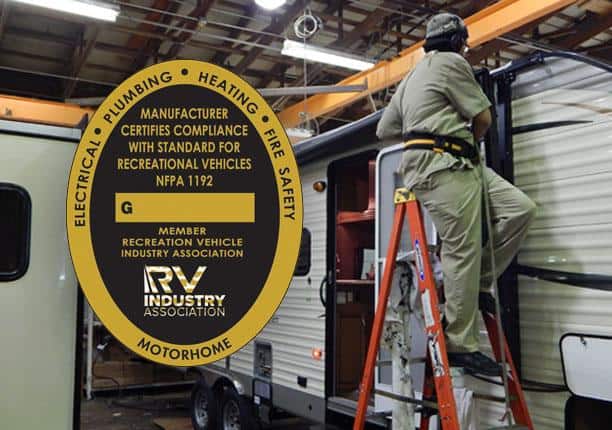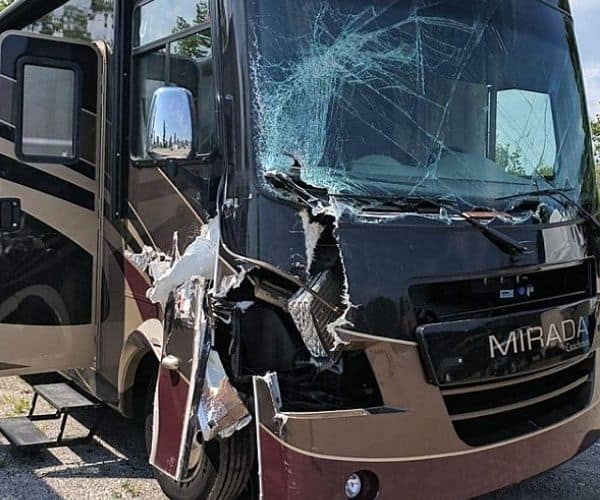RV and vehicle safety have come a long way over the years but just how safe are RVs and are there things you should be concerned about when traveling in an RV?
To answer this question, we will be taking a look at both RV vehicle construction and safety as well as different ways to stay safe while traveling in an RV.
RV Vehicle Safety
When it comes to RV vehicle safety, there are a lot of considerations and concerns RV manufacturers have to consider and contend with.
This is because an RV not only has to be safe on the road but also has to be safe as a home.
So when examing RV vehicle safety you need to not only consider how safe the RV is while driving down the road and in crashes but also how safe the RV will be when parked and using it as a home away from home.
What is an RVIA Seal and How Does it Impact RV Safety?

RVIA stands for RV Industry Association and their inspection program and seal is one of the best ways to ensure that the RV you buy is safe as well as reliable.
Because in order for an RV manufacturer to gain the RVIA Seal and become a member, the manufacturer must agree to unannounced inspections, adhere to over 500 different safety and construction standards including electrical, plumbing, heating, propane, and fire safety, and inspect each one of their RVs for safety compliance.
To find out if the RV your thinking about buying has the RVIA Seal, check out the current RVIA member list by clicking here.
Are RVs Safe to Drive?
There are many differences between an RV and a standard passenger vehicle and these differences can have a large impact on safety.
To illustrate this point we have included this helpful table that highlights some of the major differences between an RV and a passenger vehicle.
Differences Between an RV and a Passenger Vehicle and How it Affects Safety
| Type of Vehicle | Length | Height | Weight | Construction Material |
| Class A RV | 30 to 45 feet | 10 feet | 12,000 to 30,000 pounds | Fiberglass, Wood, Steel, Aluminum |
| Class B RV | 17 to 20 feet | 7 to 9 feet | 6,000 to 8,000 pounds | Steel, Aluminum |
| Class C RV | 21 to 45 feet | 10 feet | 10,000 to 15,000 pounds | Fiberglass, Wood, Steel, Aluminum |
| Sedan | 14 to 16 feet | 4 to 5 feet | 2,000 to 3,500 pounds | Steel, Aluminum |
| SUV | 14 to 18 feet | 5 to 6 feet | 4,000 to 5,000 pounds | Steel, Aluminum |
| Mini Van | 16 feet | 5.5 to 6.5 feet | 4,000 to 5,000 pounds | Steal Aluminum |
As you can see there is a considerable size and weight difference between an RV and a passenger vehicle but how does this affect the safety of the vehicle?
While most might assume overall safety would improve in an RV due to its superior size and weight, in actuality it is typically safer to travel in a passenger vehicle compared to an RV or motorhome for several different reasons.
RV vs Passenger Vehicle: Construction
A passenger vehicle is generally safer compared to an RV in a crash due to the different construction methods used in each type of vehicle.
Because while both vehicles start with a steel frame and chassis, the body of the vehicle is usually constructed quite differently when comparing passenger vehicles and RVs.
As passenger vehicles are designed and constructed using incredibly strong steel or aluminum frames.
While most RVs are built using either wood or steel stick frame construction.
Because of this, passenger vehicles tend to protect occupants better in a crash compared to RVs, which can quickly be torn apart during the extreme forces of a crash.
RV vs Passenger Vehicle: Safety Features
The second reason why passenger vehicles are safer to drive compared to RVs is because of the additional safety features found on most passenger vehicles that are typically not found on RVs.
While all modern RVs and motorhomes due have basic safety features such as seat belts, front and rear bumpers, and brake and signal lights.
The standard passenger vehicle typically has many additional safety features beyond the basics, such as front and side airbags, traction control, active lane, and brake assist, and electronic stability control.
RV vs Passenger Vehicle: Size and Weight
While the large size and weight of an RV can play to your advantage in minor accidents and crashes, it can also be a hindrance as well.
For example, due to the extreme size and weight of an RV, it can be much more challenging to slow down and stop, increasing the distance needed for stopping considerably.
The large size of an RV also makes it more challenging to maneuver and steer in an emergency situation making it much more difficult to avoid an accident.
Finally, the larger size of an RV makes it more susceptible to outside forces such as wind which can cause the trailer or RV to sway back and forth leading to instability and even crashes in extremely windy conditions.
Are RVs Safe in a Crash?

RVs are generally pretty safe in minor crashes or accidents due to their sheer size and weight. However, in major accidents and at higher speeds, RVs do not provide a lot of protection to occupants due to the type of construction used in most RVs and the lack of advanced safety features such as side-impact airbags, stability control, and pre-collision technology.
Your level of safety in a crash is also impacted by the type of RV you’re traveling in, as the different RV classes offer varying degrees of protection and safety in a crash.
Class A RV Crash Safety
Class A RVs which are usually built on a bus chassis are the largest type of RVs on the road today.
And while they tend to be relatively safe in minor crashes due to their enormous size, they are usually the least safe if you were to be involved in a major accident.
One of the main reasons for this is due to the type of construction used in a typical class A RV.
Which is often just stick-frame construction using either wood or metal studs with a thin layer of insulation, plywood, and fiberglass over the top.
This type of construction is problematic in an accident because it can not withstand the extreme forces experienced in a major crash.
This is why if you ever see a major crash with a class A RV, the RV will usually look like it was ripped to shreds because the forces of a crash will literally tear the body of a class A apart.
Just check out this YouTube video showing the damage to an RV after a crash at relatively moderate speeds.
Another reason class A RVs are often the least safe is they are not required by law to be crash-tested by the manufacturer or the NHTSA (National Highway Traffic Safety Administration).
And because of the lack of crash testing, it can be difficult to know or prevent safety issues or weaknesses in a class A RV.
Class C RV Crash Safety
Class C RVs which are built on a truck chassis tend to be a little safer in crashes compared to class A RVs due to their semi-enclosed truck cab at the front of the RV.
However, passengers riding in the back of a class C RV will have the same safety issues in a crash as a class A RV.
This is because the back portion of a class C RV is built and designed with the same stick-frame construction that a class A uses for the entirety of the motorcoach.
Also, while the truck chassis, frame, and front cab of the class C RV are crash-tested by the NHTSA, the body of the class C RV is rarely tested.
This again makes it difficult to detect or known weak points or safety issues in the construction of a class C RV in a crash.
Class B RV Crash Safety
Class B RVs are the smallest of the three classes and are built using a van chassis such as the Ford Transit, RAM Pro Master, or the Mercedes-Benz Sprinter.
And because the class B RV is built on a standard work van chassis it is one of the safest types of RVs currently on the road today.
This is because unlike class A and C RVs, class B RVs, or more specifically the vans they use in their construction, are required to meet minimum safety standards and are crash-tested by the NHTSA.
In addition, thanks to the all-metal body construction of a class B RV, they tend to withstand the extreme forces of a crash much better than a class A or C RV.
Class A RV Crash Test
While US RV manufacturers rarely crash test their RVs, if you would like to see what a crash test of an RV looks like, check out this YouTube video that shows the Swedish Government crash testing a class A RV.
How Common Are RV Accidents?
While there is not a lot of current data or statistics available for RV crashes specifically, we were able to find some information about how many RV crashes happen per year.
The Federal Motor Carrier Safety Administration which is a part of the United States Department of Transportation released a report in 2003 that stated that more than 70,000 people were involved in RV accidents that year.
They also released another report in 2012 that stated that 75,000 injuries were reported in that year due to RV accidents.
In addition from 2000 to 2007, the Fatality Analysis Reporting System found that 212 people died in RV accidents.
This means that approximately 30 people died each year due to RV accidents.
Which is certainly a sobering number, however, when you take into account that 38,000 people die each year in the US due to car accidents, it does help to put it into perspective.
However, the stark difference in these numbers can mostly be attributed to the fact that there are far more cars on the road than RVs.
7 Leading Causes of RV Accidents
One of the best ways to avoid being involved in an RV accident and becoming another statistic is to know the leading causes of RV accidents, so you can hopefully avoid them.
Beginner and Inexperienced RV Drivers
One of the leading causes of RV accidents each year are inexperienced and beginner RV drivers.
As inexperienced RV drivers are far more likely to make mistakes while driving which can often lead to accidents.
This is because driving an RV can take some getting used to, as there is a big difference between driving an RV and driving a car.
Which often requires a new RV driver to develop a whole new set of driving skills to handle the additional length, width, and weight of an RV.
Speeding
One of the leading causes of accidents on the roadway today is speeding.
And RVs are even more likely to be in an accident due to speeding due to the large size and weight of the RV which can make it more difficult to maneuver and stop.
Distracted or Tired Drivers
Driving distracted or tired is always dangerous no matter what type of vehicle you’re driving.
But these dangers are more likely in an RV. As you are far more likely to be distracted by what is going on inside the motorcoach while driving an RV.
Also, you are far more likely to drive tired due to the type of long-distance destination driving usually done in RVs.
Elderly or Senior Drivers
While senior or elderly drivers tend to drive more slowly and cautiously compared to younger drivers, they also tend to have worse vision and slower reaction times, which is why senior drivers are a leading cause of RV accidents.
Longer Stopping Distance
RV drivers often miscalculate the amount of space they need to stop their RV because they fail to take into account the larger size and weight of an RV, which can often cause an accident.
High winds
While high winds in a car can be an annoyance, high winds in an RV can be dangerous due to the height of the RV and the higher center of gravity.
As high winds can cause an RV to lose stability and even rollover if the winds are severe enough.
Increased Blind Spots
While it’s not uncommon for most vehicles due have a few blind spots, RVs often have many blind spots due to the length of the RV which makes it difficult to know where other vehicles are around the RV, leading to accidents.
Tire Blow Outs
An often overlooked danger and a leading cause of RV crashes are tire blowouts which can be extremely dangerous and lead to accidents especially if the blowout were to occur at higher speeds.
RV Travel Safety
Below are some of the top ways RVers can keep themselves and their families safe while traveling in an RV.
Top Ways to Stay Safe While Traveling in an RV
- Know how to operate your RV and all its safety features both inside and out.
- Practice and learn how to handle and drive your RV by practicing turning, backing, and parking in a large empty parking lot before hitting the open road.
- Consider purchasing a membership to a roadside assistance program like AAA, which will prevent you from being stranded on the side of the road, as they often provide towing services, battery jump-starts, flat tire replacement, locksmith services, emergency fuel, and minor mechanical repair.
- Know and keep track of the weather to avoid unsafe driving conditions.
- Perform a pre-drive checklist to make sure everything is locked in place and ready for travel.
- Follow the rule of 20% when driving an RV which is a way of consciously allowing for the larger size and weight of an RV, by leaving 20% more space than you normally would between you and other vehicles.
- Know the exact height of your RV to prevent damage to your RV by driving under overpasses or bridges that do not provide enough clearance for your RV to travel under.
- Make sure you have proper weight distribution throughout the RV.
Can You Walk Around in an RV While Driving?
It is not safe to walk around in an RV while it is moving, as you can easily be hurt and are much more susceptible to injury if the RV were to be involved in an accident.
To keep you and your family safe while the RV is moving, all passengers should be seated with their seat belts fastened.
In addition, many states have laws specifically requiring that all passengers wear their seat belts while traveling in an RV.
Recent Posts
Picture this: you're parked at a scenic campsite, the great outdoors stretching out before you. You step outside your RV, ready to soak in the fresh air and beautiful views. But wait - something's...
Are you ready to hit the open road in your RV? Before you set off on your adventures, it's crucial to have the right RV travel tips and RV accessories up your sleeve. As a seasoned RVer, I've...

